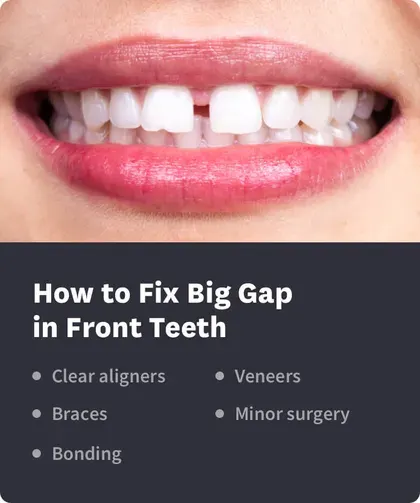Diastema: Causes, Symptoms, & How To Fix Gap In Teeth

Table of Contents
- What is Diastema?
- Key Facts About Diastema
- Causes of Diastema
- What Are The Symptoms?
- Treatment Options
- Preventing Diastema
- Using Byte to Manage Diastema
- FAQs
- References
The American Dental Association defines diastema as a space between two adjacent teeth in the same dental arch.
If you have diastema, treatment options include braces, aligners, veneers, and more. The bigger the gap, the more intense the required solution will be. But with the gap closed, you'll have a healthier mouth.
What is Diastema?
A space between two teeth that should touch is diastema. Some people have them on the top arch between their middle teeth, but others have them in less visible spaces, including farther back in the jaw.
You may have been born with it or done something early in life (like sucking your thumb) that pushed your teeth apart.
Four Key Facts About Diastema
Some people are born with them. If your parents had gaps in their teeth, you may have the same issue.
Some people develop them. Childhood habits (like sucking your thumb) can push teeth apart. Poor oral health can also cause gaps to form.
Diastema is known by other names. Some people call this condition “gaps in teeth.”
Some people find this trait attractive. In Nigeria, a gap between front teeth is generally regarded as a symbol of beauty.
What Causes Diastema?
Gaps form for all sorts of reasons. But these are the most common:
Researchers say some people have genes that lead to gap-toothed smiles. If your parents, grandparents, and siblings have gaps, you will likely face the same issue.
You can cause a gap (or make an existing one worse) through three habits:
Sucking your thumb: Children who suck their fingers and thumbs can push their teeth forward and apart.
Pushing your teeth with your tongue: Swallow, and watch how your mouth moves. If your tongue presses the back of your front teeth, they can move forward and apart.
Ignoring dental health: Gums help to hold your teeth in place. If you avoid brushing and flossing, bacteria colonies can flourish and allow your teeth to move.
Your oral anatomy can also lead to diastema. If your tongue is large and fills up your mouth, it will press on your teeth each time you talk, bite, and swallow. That pressure can shift your teeth to new places.
If your teeth are too small in relation to your jaw, your teeth can also slide apart to take up space. If you're missing teeth, the same issue can take hold.
Braces and aligners should move your teeth into proper placement. But if you have a poor experience with orthodontics, you could cause more problems than you fix.
What Are Diastema Symptoms?
Diastema is easy to spot in the mirror. Open wide, and look for a gap that's about 0.5 millimeters or larger.
Other symptoms can include the following:
Spitting: You may spray saliva between your teeth when you talk or swallow.
Trapped food: Particles may collect in the space between your teeth.
Pain while eating: Sharp food (like chips) could stab you in the gums due to gaps.
Treatment Options for Diastema
What's the best way to fix a gap between your teeth? Five treatment types exist, and they all come with advantages and disadvantages.
| Best for gaps that are: | Treatment time: | Cost: | |
|---|---|---|---|
| Bonding | Small | 1 visit | Around $300 |
| Veneers | Moderate | 1 or 2 visits | Up to $2,500 per tooth |
| Surgery | Small | 1 visit plus recovery time | $250 to $1,200, depending on the dentist |
| Braces | Severe | About 2 years | $5,000 to $6,000 |
| Aligners | Small or moderate | About 4 months | About $2,000 |
Bonding
Your dentist applies a small amount of tooth-colored materials to each front tooth. As the layers build up, the gap closes.

Benefits of this method:
Speed: You're done in just one visit.
Comfort: Skip pain associated with braces and surgery.
Cost: Pay an average of $300 for the work.
Drawbacks of this method:
Color: Drink plenty of coffee or tea, and your bonded material can shift from white to orange.
Fragility: Your bonds can chip or crack.
Persistence: If an underlying health condition (like tissue between your teeth) causes the gap, it will return or worsen.
Veneers
Your dentist glues tooth-colored shells to the front of your teeth and cements them in place. Choose porcelain versions that last for years, or opt for resin versions that cost a bit less.
Benefits of this method:
Speed: You're done in one or two visits.
Comfort: Your teeth won't move, so veneers are generally less painful than braces or aligners.
Appearance: If the teeth next to your gapped versions are also chipped or discolored, treat them with veneers too.
Drawbacks of this method:
Cost: The better the veneer material, the more expensive the work will become. Some people pay $2,500 per tooth for veneers.
Damage: Your dentist must remove tooth enamel to apply veneers. Your enamel will not grow back.
Staining: Resin veneers can stain if you drink wine, tea, coffee, or other pigmented drinks.
Replacements: Veneers can chip and crack. If they do, you'll pay for replacement versions.
Tissue Removal
Sometimes, the tissue between your teeth causes a gap. Removing this excess tissue can give your teeth the freedom to move closer together. Dentists call this a frenectomy, and it could give your teeth space to come together.
Benefits of this method:
Speed: You're done in just one visit, but you will need a few weeks of recovery time.
Medical necessity: Added gum tissue allows pockets of bacteria to grow. Your dentist could suggest that your surgery is required, which could mean your health insurance covers it.
Drawbacks of this method:
Risk: While added gum tissue can push teeth apart, removing it won't necessarily encourage them to come together. You may need another procedure to improve your smile.
Staging: If you need another tooth-straightening appliance (like aligners), you might need them before your frenectomy.
Pain: Gums are filled with nerve endings. Scraping them away hurts.
Cost variance: The price varies widely from dentist to dentist.
Braces
Metal wires attached to metal brackets pull your teeth into proper alignment. Visit your orthodontist periodically for checkups, and they’ll clip your wire to make it shorter. Skip those appointments, break off brackets, or otherwise harm your appliances, and you'll significantly increase your treatment time.
Benefits of this method:
Effectiveness: If you have a large space between your teeth, and other teeth in your mouth are crooked, this approach is best. You'll get all of the help you need.
Supervision: An orthodontist manages your care in a series of appointments. If something goes wrong, your doctor is there to help.
Drawbacks of this method:
Cost: Prepare to pay $5,000 to $6,000 for standard metal braces. Opt for fancy versions (like ceramic brackets or lingual braces that sit behind your teeth), and you will pay more.
Time: Spend an average of two years in treatment.
Pain: Moving teeth hurts, and brackets can tear at soft tissues in your mouth.
Inconvenient: You must keep your appointments, and your dental hygiene routine will take longer too.
Aligners
Plastic trays coat your teeth, and you swap out old ones for new versions on a schedule set by your doctor. Work with Byte, and a doctor manages your care while you're at home.
Benefits of this method:
Effective: Mild-to-moderate gaps can be addressed with aligners.
Supervision: A doctor manages every step of the process.
Cost: Clear aligners are much less expensive than braces. Byte treatment costs about $2,000.
Cleanliness: Take out your aligners to brush and care for your teeth.
Drawbacks of this method:
Not always suitable: Aligners can't fix big gaps or other severe issues.
Discomfort: You'll feel pain for a few days each time you change trays.
Time: Prepare to spend about four months in treatment.
Can You Prevent Diastema?
You can't change your genetic makeup and some parts of your oral anatomy. But you can make strategic choices to reduce your risk of developing a gap-toothed smile.
You can do the following:
Prioritize oral health. Brush, floss, rinse, and visit your dentist for cleanings. Healthy teeth are less likely to fall out or slide apart.
Work with a therapist. If you push too hard on your teeth with your tongue, visit an occupational therapist. Changing the way you talk and swallow may help.
Change your habits. Don’t suck your thumb, chew on straws, or gnaw on pencils. Remember that your teeth aren’t tools.
Using Byte to Manage a Gap in your Teeth
Don't let diastema keep you from sharing your smile with the world. Try treatment with Byte.
Clear aligners wrap around your teeth and gently move them into the proper position. The HyperByte tool helps seat the trays on your teeth, and the gentle vibration speeds up treatment times while lessening your pain.
A talented dental professional supervises your case from start to finish, and you have customized help when you need it at any point in treatment. Within a few months (on average), you'll have the smile you always wanted.
Diastema Frequently Asked Questions
Bonding, veneers, surgery, braces, and aligners can all fix gaps between front teeth.
There are no DIY or natural methods safe to use on gapped teeth. You must work with an oral health professional to do the job right.
Costs vary between $300 and $6,000, depending on the method you choose, the severity of your gap, and the professional you're working with.
Professionals such as the American Dental Association do not define diastema as a disorder. It's a gap between teeth.
It depends. People with gaps caused by oral health issues will have worsening problems as long as their dental issues continue. But if you have diastema due to a genetic issue, your gap may never get bigger.
Diastema doesn't spontaneously get better. But treatment is very effective, and gaps are responsive to solutions like braces, veneers, bonding, and aligners.
